Cabinet Card was the Most Common Family Portrait
The cabinet card was made by using the same steps for creating CDVs, still exhibiting the sepia look. However, the cabinet card's image area was more than double the CDV. It was introduced in the late 1860s in England, but did not gain much attention in the U.S. until the mid-1870s. While it was a bigger image than the CDV, it did not offer much of a quality difference until the mid-1880s. That is when the effect of new photographic papers and camera improvements really became apparent.
Many cabinet card photographs from the 1880s and 1890s are exquisite pieces of artwork, exhibiting technical excellence and wonderful composition. This new size and improved clarity and colors provided the perfect media to showcase the grand styles of the gay nineties.
Is My Image a Cabinet Card?
These are just as easy to recognize as CDVs. Though examples from the late 1890s show a wide variety of card stock, and some variation in sizes. Basically though, most cabinet cards are 6 1/2" x 4 1/4".
Cabinet Card Characteristics
The cabinet card experienced many style changes and improvements during its lifetime. Dating them is quite easy. Some of the characteristics to look at include:
-
Color of card
-
Artwork and print on the card
-
Card borders and edges
-
The photographic paper
-
Backgrounds, dress, and styles
|
| |
Card Colors
Initially, cabinet cards were made from natural raw bristol board, both front and back. But in the mid-1870s the backs were coated with soft off-white or even light pastel ink. The two most advertised card colors were primrose (pale yellow) and pearl (rich off-white) though light pink, blue, and green can be found.
In the mid-1880s dark colored cards were introduced and used until the early 1890s. The most popular was a dark maroon and black. Green was a very attractive version, but examples are harder to find.
While the dark cards are not rare, they did not capture a large share of the marketplace, possibly because they were more expensive than standard colors. Compared to primrose or pearl cards noted earlier which were $1.10 per hundred, maroon cards were $1.20 and black were $1.30 per hundred.
General Rule: Dark cards popular from 1885 to 1895 |
| |
|
|
|
Imprints - Front and Back
Imprints are the text and artwork printed on the card. The front usually includes the studio or photographers' name and location. The back sometimes includes the same information, but more elaborate.
Front Imprint
Several style changes are easily datable. Artistic print means the typeface used is highly ornate cursive style.
| Small, plain print
Artistic print
Foil stamped artistic print
Embossed artistic print |
1866 - 1884
1882 - 1900
1890 - 1900
1894 - 1900 |
Back Imprint
The backside of the photograph became an elaborate advertisement for the photographer. The following trends have been observed:
Medium size (less than half the back)
Artwork covers nearly all the back
|
1866 - 1890
1888 - 1900 |
Note: The back was frequently left blank to reduce costs.
General Rule: The fancier, the later the date. |
| |
|
| |
Card Borders
The borders (lines or artwork on the card) and the manner in which the card edges were cut or treated are some of the best known clues to dating the cabinet card. Characteristics to look for are:
Borders
|
None
Thick gilt border to card edge
Single thin line
Embossed patterns
Artistic underscore |
|
1866 - 1900
1878 - 1886
1884 - 1900
1894 - 1900
1886 - 1896 |
General Rule: No single rule applies across all cards
Card Edges
Card edges experienced numerous changes during the latter 1800s. These included beveled edges, gilt treatment, and scalloped edges. Throughout the time however, plain straight cut edges could be found also. The simplest ones were the cheapest and there was always a market for them.
Plain cut
Beveled
Scalloped
|
1866 - 1890
1892 - 1900
1886 - 1900
|
General Rule: Most fancy edges are from the 1890s
|
| |
|
|
Get The Detailed Source of Information
The new 19th Century Card Photos KwikGuide
|
Everything you need in a step-by-step guide to help you establish a reliable date of your cabinet cards.Read More
|
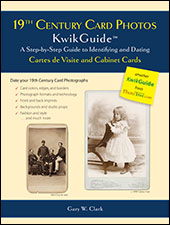 |
|
|
|
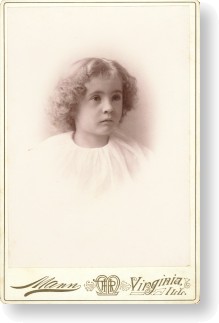
1892 Cabinet Card.
Timeline:
- Appeared: 1866
- Peaked: 1875-1895
- Waned: 1896-1900
Characteristics
-
Image on thin paper, mounted on card stock
-
Early cards were sepia (brown tone), later photos were silver-like tones and rich blacks
- Edges can be beveled, gilded, or scalloped
Common Size
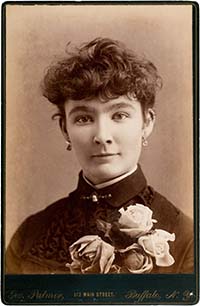
ca 1887 cabinet card on dark green stock.
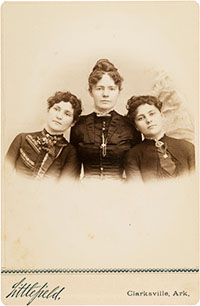
1888 cabinet card shows a single artistic line below the image, used from about 1886 to around 1895.
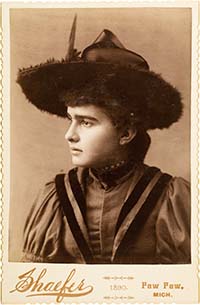
1890 cabinet card with scalloped edges.
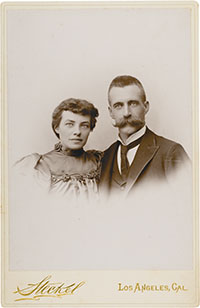
1895 cabinet card with rich soft tones.
See the Gallery of 1,000 Images for a collection of dated Cabinet Cards. Click here: Gallery Cabinet Cards
|
|
|
|